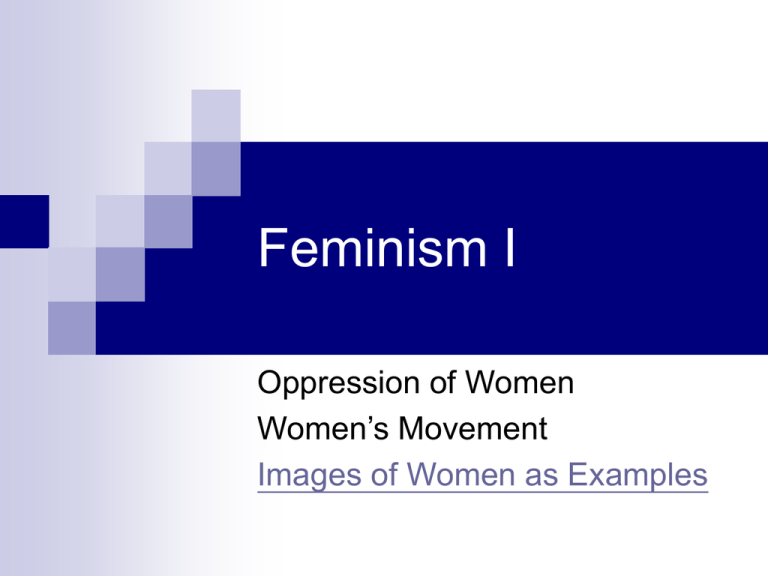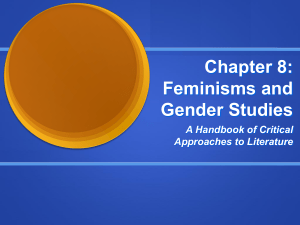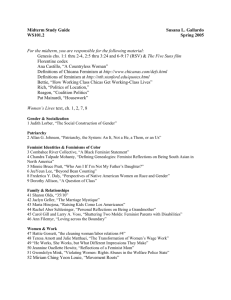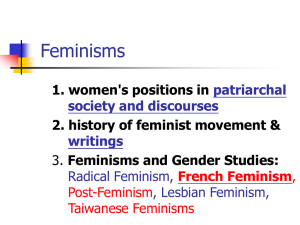
Feminism I
Oppression of Women
Women’s Movement
Images of Women as Examples
Outline
Course Review: Q & A
From New Criticism to Feminism
Feminisms: Starting Questions
Course Review Q & A
What have we done so far?
Romantic/Victorian Poetry about Nature and
Quest. Main Points?
Wordsworth – seeking redemption and sublimation
first in nature and then in memories and imagination
about nature
Keats – nature with its contradictions, as a vale of
soul-making
Women – supplementary (Dorothy Wordsworth) or
used as symbols (Melancholy, La Belle Dame)
New Criticism
Text as an organic whole
From New Criticism to
Feminism
1. autonomous self/text, universal human nature
Feminism: Self/text conditioned
— gendered and (de-)sexualized
— by society and history, and more specifically, by
patriarchal society.
2. Methodologies:
-- Close reading (of both form and content) is still important;
-- symptomatic reading – instead of reading for the text’s
wholeness, we read for its holes and/or biases
-- reading against the grain – alternative readings
Feminisms: Starting Questions
Who is a feminist? Are you a feminist?
Can a man be a feminist? Clip 1
gender difference: What are the
differences between men and women?
Biology--Is
our body our destiny?
Personality & Behavior --What is “being
feminine” like?
Career Aptitude—Are there jobs unsuitable for
women?
Writing--Do men and women write differently?
Feminisms: Starting Questions(2)
Images of Women:
What
are the traditional/stereotypical images
of women (as a mother, as a career woman,
as a college girl and as a daughter)? What’s
wrong with them? (one simple example)
How do women deal with those traditional
images? Rejecting them completely?
How do women look at women and women’s
images? From a man’s perspective, or a
woman’s?
Young Women in Dove
Commercials
Young Women in Dove
Commercials
Images of “long-straight-hair” women –
conformity stereotype of campus
beauty
Non-professional user account – apparent
reliability
Feminisms: Starting Questions(3)
Feminine Writing, Feminist writings and
Women’s work:
What
is feminine writing? Does it have
definite features?
Are all women writers feminist writers?
What are the feminist strategies used in
feminist writings and cultural productions?
Feminisms: Starting Questions(4)
Body, Desire, Sexuality and Sexual Orientation:
How
do women express/liberate their desires? Is
sexual liberation the only good way? How about
body sculpture?
How is our sexual orientation determined?
Genetically? By family background? Or by choice?
What is “good sex” and what is “bad”? (How about
S/M?) How is marriage or love related to sex?
Should pornography be banned? And prostitution be
legalized?
Feminisms: focuses in class
1. women's positions in patriarchal
society and discourses (this week)
2. history of feminist movement &
writings
3. Feminisms and Gender Studies:
Radical Feminism, French Feminism,
Post-Feminism, Lesbian Feminism,
Taiwanese Feminisms
What is patriarchy?
1. male domination and limitation of women in
society; e.g. foot binding, Hijab, Purdah
system, Sati.
2. male superiority in ideologies (e.g. Aristotle
declared that "the female is female by virtue
of a certain lack of qualities"; St. Thomas
Aquinas:woman is an ‘imperfect man’;
Confucius)
3. in language and literature (e.g. chairman,
the universal "he"; God as "He"; in Chinese:
妒、姦、妙、佞, etc.
4. in sex and biology (women as rapable,
receptacle of sperm)
Male Dominance in Literature
before 20th century.
Predominance
of male writers
Women limited to writing in certain genres (e.g.
diary, letter, romance).
Stereotypical presentation of women;
goddess, mistress, fallen women and femme
fatale.
Male Dominance in Literature
Objectifications of Women – Angel or Whore
1. Stereotyping
Idealization;
Degradation
Male Dominance in Literature (2):
Images of Women
1) as objects of desire--e.g. "Araby," "La Belle Dame Sans
Merci" "To His Coy Mistress" and courtly love poetry, “Shall
I Compare Thee to a Summer’s Day?”
2) as symbol--"Young Goodman Brown," "Grecian Urn" "To
Autumn“; “Ode on Melancholy”
3) as Other or Villain – Snow White’s Stepmother; Fatal
Attraction
4) women inferior or subordinate--Eve, romance (knight
and lady), 007 films and the other Hollywood films (Working
Girl, Coma, Silence of the Lamb)
Male Dominance in the Other
Cultural Products
Classical Nude Paintings and PreRaphaelite Paintings
Hollywood Films
(contemporary ambivalent ones: Switch)
Music videos
Commercials, advertisement
“The Female Body”
“The female body has many uses. It’s
been used as a door-knocker, a bottleopener, as a clock with a ticking belly, as
something to hold up lampshades, as a
nutcracker, just squeeze the brass legs
together and out comes your nut. . . .
“ Margaret Atwood











